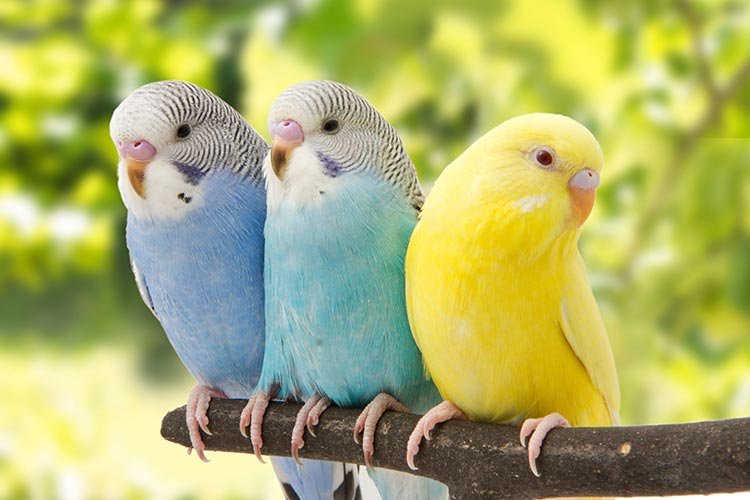
Budgerigars are one of the most common birds to keep at home, because of their beauty, their relaxing singing and how easy is taking care of them. Budgerigars are also known as budgies, as well as parakeets.
Types of budgerigars
Where do budgerigars come from?
The budgies are from Australia and the species was registered in 1804. When this small animal was discovered, its beauty caused that thousands of them were captured for selling purposes. However, the long journeys for transport and the lack of knowledge about the feeding of these animals led to the death of more than 95% of the ones that have been captured.
How do parakeets look like?
Parakeets are usually 18 cm long from the head to the tip of the tail, although some of them may be slightly larger. The weight of a parakeet is about 35 grams. The wild parakeets, one of the best known types of budgerigars, are light green at the bottom of the tail, with the head in yellow and black. Their throat and forehead are yellow with a purple cheek patch and black throat spots on each side.
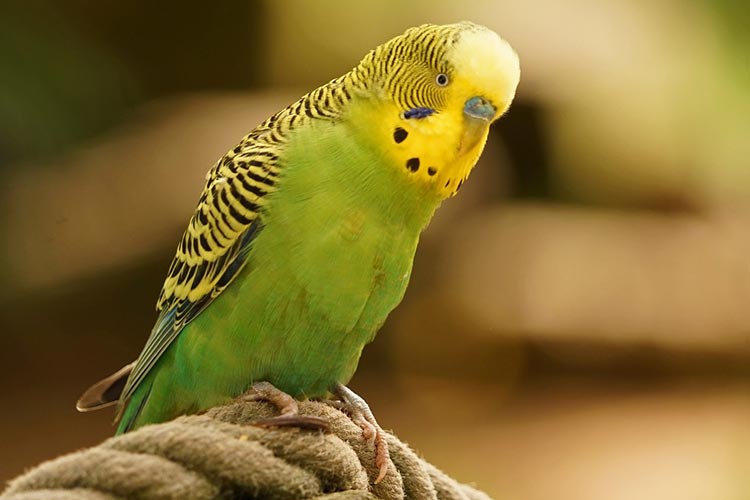
In the middle of the body they have black spots, which are only visible when they spread their wings. Their beaks are curved downwards, greenish-grey in color and their legs are bluish-grey, with two fingers forward and two fingers backward. It makes it easier for them to stand on tree branches, cables and feed on seeds.
How is a parakeet behavior?
Unlike other birds, parakeets are very sociable animals. They tend to live in flocks, although they are quite territorial even among their own species. With human beings they don’t usually have many sociability issues, being able to get used to being with them and treating them as one of their own.
When budgies live in captivity, there are a several guidelines to help the owner know the status of the pet parakeet. For example, when a budgerigar cleans its beak with its feathers, putting each feather in the right place, the animal will be grooming itself, a sign that it feels comfortable in its cage. As the beak will also be cleaned, it will make its classic gurgling. Some parakeets are shy and sometimes it’s hard for them to sing.
It’s not the only sign this animal will have. The position they take is also a message to the owner. If the budgie is standing on one leg it means that it’s resting. If it’s stretching a wing and a leg at a time, it means that it needs to exercise, but the cage is too small or it’s feeling quite trapped.
If the parakeet lifts its plumage with the body in the shape of a ball, it’s a sign that it’s cold and needs some heat. In these cases it’s necessary to move it to a warmer part of the house or where the sun shines. However, if it separates its wings from the body with its beak slightly open, it’s a sign that the budgie’s hot. In these cases, it’s better to put in the cage a little container with water, so that the bird can bathe and cool down.
When frightened, the budgerigars attach their plumage to the body, keeping it rigid and breathing quickly. It’s normal if it has its neck stretched up. They may have been frightened by something they heard outside the cage or if someone appears unexpectedly. In case of being released, it’s not a good idea to take them back to the cage. They will come back on their own.
Unlike other animals, parakeets love noise, especially from the environment. So if you turn on the TV or radio around them, the budgerigar will surely be watching or listening to it. Although they like noise, they get easily scared, so you have to be careful when treating them.
How do several parakeets live in the same cage?
Budgies are sociable animals, but they’re also territorial. In case of having more than one budgie in the same cage, it’s essential that they live together from the beginning.
Two male budgerigars will fight each other to see who owns the cage. They will try to be the “bosses” of who will eat first, who will drink first, who will climb on a stick, among others. They will not kill, but they will probably try to hurt each other. When you have two female budgies, it’s normal for them to fight each other, especially if there’s only one male budgie in the cage.
That’s why these animals have to live together from an early age or buy a cage large enough for them to move freely and have their own territory.
How to tell the age and sex of a parakeet
Although it may not seem so, distinguishing the age and sex of a parakeet is very simple. Age is determined by the lines on the forehead. Young parakeets have their foreheads covered with lines, while adults have them smooth. Young budgies have feathers with less intense colors. Another way to tell the age of a budgerigar is the color of the eyes: young parakeets have a completely black eye, while older budgerigars have a white ring with a black dot.
How to tell if a parakeet is a boy or girl? Another key is in the cere or the top of the beak around the cere. Male parakeets have this area completely blue, while female parakeets have a white-beige color, except in their heat stage, when they have it brown.
All about parakeet cages for your pet
The most important question when it comes to taking care of your budgerigar is: which cage to buy? The budgie may get used to living around the house with freedom, but most of the time will be spent in a cage. That’s why it’s important to choose it well.
The minimum size of the parakeet cage must be 50 cm wide if it’s to accommodate a single budgie. In case of housing two birds, it’s better to have a width of one meter. You surely wonder why so wide and tall. The height will actually be about 30 cm, but this is not that important. The reason is because parakeets make more use of horizontal space to move than vertical. The best when buying a parakeet cage would be one with horizontal bars, so the budgies can climb the walls of the cage to take a look at the outside.
The shape of a parakeet cage
Many people make the mistake of buying a round cage. Buying these types only causes the bird to become disoriented. Therefore, it’s better to buy a square or rectangular one. It’s not recommended that white bars for the, as this makes it difficult for the budgie to see. The spacing between bars should be at least 1 cm, because if it’s smaller the legs or beak could get caught between them. The more doors it has, the better you can put in the water dispenser and the feeder.
Accessories and toys
Once the cage is chosen, it’s time to select the accessories. By default, the budgie cages already have a number of accessories such as a feeder, a hanger or a toy. Many cages fail in the parakeet feeder. Generally, they’re hung outside the cage and they’re transparent, which is not recommended for parakeets as they’re forced to stick their heads through a hole to feed. Transparent feeders make the parakeets believe that they can escape, so they will try to empty the dispenser to try it.
For this reason, the best parakeet feeders are those that hung inside the cage. They’re easy to fill and are quite easy to clean. You don’t need to worry about the water dispenser. You just choose a dark plastic one.
Many people decide to keep the hangers included in the cage, but it could be an error. Most of them are made of white plastic with stretch marks. These stretch marks cause wounds in the parakeet’s legs. It’s better to replace these bars with natural branches. It’s not necessary to buy it, any tree branch, properly cut, can be used.
They provide a better grip for the budgerigar, they’re more resistant and don’t injure its legs. These same branches are also good for cleaning its legs and beak when it wants to groom itself.
Like other pets, parakeets love toys because it helps them get out of their routine. The one they like the most is the swing, but they also like the rope and the ladder. There’s no need to fill the cage with many toys, as it may stress the bird. Besides, mirrors or toys that can reflect the light should be avoided, as this will be bothersome and stressful for the budgie.
Cleaning of the cage
It’s recommended to put newsprint at the bottom of the cage, which will make the cleaning easier. In summer, it’s a good idea for the budgerigar to have a water container inside the cage where it can cool off. The container should be removed once it has finished.
Where to put your budgie’s cage
The biggest mistake most pet owners make is to place the budgie cage in the kitchen, an area where they’re exposed to fumes and vapors that are dangerous. Nor can they be placed near a TV set or under fluorescent tubes, as the sight of parakeets detects rapid flashes of light that are annoying to them.
So, where to place the parakeet cage? The living room, near a window and away from the TV is a good place to keep the cage. It’s one of the busiest rooms in the house and allows them to hear the noise from outside, as they love the noise. At first they may feel frightened, but they will get used to the atmosphere and will love the area. A sunny area in the morning and dark at night is perfect. You can also help them sleep better by covering them at night with a dark blanket, taking care to leave a space for air to pass through so they don’t choke.
If you choose to hang the cage, it should be as high as your eyes. It helps them to see everything from above, which is what they are used to.
Although the sun may be a benefit for the birds, you should have a special care not to leave them in direct contact with the sun rays. They cannot be in a draughty area, as this causes them to get cold. Try the different areas of the house to choose the best place for your pet parakeet.
It’s not usually highly recommended, but there’s really no big problem in moving the cage from one place to another. During the day you can leave the budgie in a sunny area, but at night in a dark area where the pet is comfortable to sleep. Try to avoid sudden movements during cage transportation.
Should I keep the cage outside?
If you have a garden and plenty of space, maybe you prefer to have your parakeet outside your house. In these cases, the cages have to be large, so it can move freely with comfort.
It must not be located in a place where it receives the sun directly without having the possibility of shelter, nor where there’s airstream. You should also consider that it has protection against rain, such as a roof over the cage and inside of it.
Once they’re located outside the house, they shouldn’t be moved from there. In an apartment they get used to the territory, so there aren’t many problems, but when it’s outside, they don’t like changes. Choose a place where the budgie can be well most of the time.
The big problem with having them outside is predators like rodents. The cages must be well protected so that rodents cannot reach them. This could lead to the death of the parakeet.
How to feed a budgerigar
The seeds are the basis of budgies diet, especially oats, but they also eat canaryseed, wheat and millet. However, there are other types of foods that they like. An example is lettuce, which should be given in small portions. A good food to give them in summer, as it contains water and it helps them to hydrate.
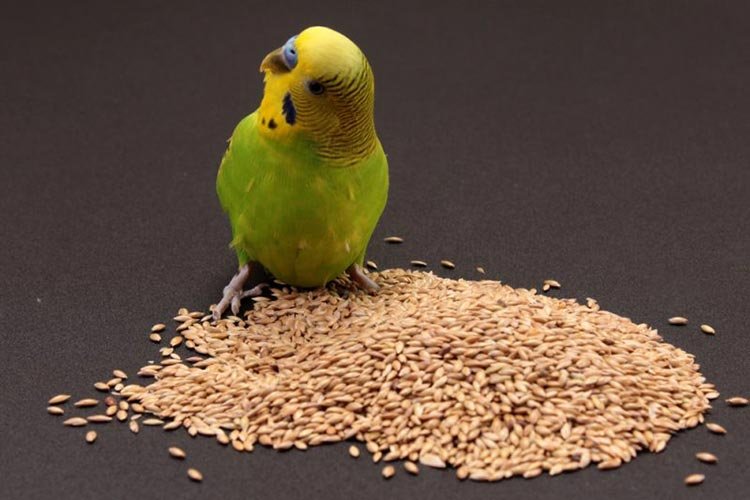
Other vegetables they can eat include carrots, spinach and chard, which provide vitamin A for their development. The apple is very good because of its high water content, although parakeets prefer to eat bananas because of their flavor. In other words, provide them food that are rich in vitamin A while they are growing, rich in calcium and especially in iodine.
If their food is based on seeds, they should be aware that they usually leave the shell, so you have to change the food in the feeder every day or they won’t want to eat. It’s not recommended to feed them with bread, pasta, cooked rice, eggs or meat. Try to keep your budgie feeding as natural as possible.
How to carry out parakeet breeding
The parakeet breeding requires a lot of work and effort. Especially if you want to have a lot of them or try different color combinations.
If you already have a male and a female, you’re close to the important part: the breeding. Parakeets can breed very young at five months, but it’s better to wait until they’re at least one year old. The reason is simple: if they’re too young, they may suffer from diseases or disorders during breeding. The fertility of the budgie starts at an early age and it can last up to six years.
Budgerigars can breed at any time of the year, however the best season for budgie breeding is spring, when temperatures are neither too cold nor too warm. They must be healthy and not be molting their feathers. It’s not recommended that they reproduce more than three times a year, because they may become exhausted and their breeding may be of a poor quality.
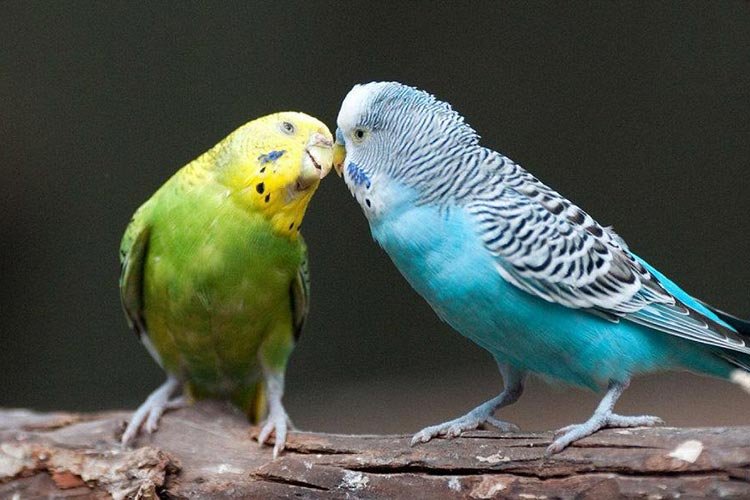
So, what can be done to motivate budgies to breed? Some parakeets breed on their own, but there are some things you can do to help them. For example, they will need something to build their nest, which they make from non-poisonous tree wood, so leaving the twigs inside the cage will motivate them to make one. Another option is to buy a parakeet breeding box, but this is something that parakeets don’t usually like very much, so it’s better to let them do it themselves.
Once they have the nest and the couple is in place, during the mating season the courtship will begin and after three or four days the copulation will begin. After that, the female budgerigar will spend the entire day in the nest until she lays the first egg. The eggs are laid every other day and there will be about 6 of them. Once all the eggs are laid, the female budgie will incubate them for about 18 days. Since there has been a difference in laying between each egg, the new brood will hatch every two days.
It’s normal for parakeets to be quite protective during their growth, so at this stage it’s better to just change their water and food. They can even attack if someone gets too close to their brood.
Parakeet diseases to be taken into account
Budgerigars are not free from disease. Some are inherited, others suffer from poor nutrition and some from the environment. It’s normal for the parakeet to feel down or stop singing, which helps to let it know that something is wrong. But sometimes these can be seen by a change in plumage or the appearance of spots.
- Parakeet beak diseases: there are several diseases that can affect the beak, one of them is the infestation of Knemodokoptes pilae. The affected budgie can experience severe itching in the beak. In the early stage crusty plaques may appear in the corners of the beak as well as in the beak itself, which become thicker and crustier over time. In an advanced stage, the beak become increasingly cavernous and itching will be stronger. This infestation must be treated and stopped in the earliest stage possible or the budgerigar may have serious and painful complications. Other parts of the parakeet’s body may be affected and, if untreated, result in death.
- Budgerigar fledgling disease: also known as BFD, a contagious disease causing high mortality if untreated. The causative agent is identified as a papovavirus and has been characterized as the first nonmammalian member of the polyomavirus genus.
- Budgie liver disease: several diseases can affect a parakeet liver, such as the hepatic lipidosis or fatty liver disease. It can be caused by the continuous consumption of seeds, peanuts, or other fatty foods the bird like to eat.
- Budgie kidney diseases: it’s common in birds, especially in budgies. Diseases like nephritis are usually undetected because they can be confused with diarrhoea. It’s characterized by droppings totally wet and of a whitish to yellowish liquid.
- Cold: if the parakeet’s cage is located in an area with a strong airstream, or where there are sudden temperature changes, it’s normal for them to get a cold. It’s not deadly, and just giving them a little warmth will help them recover.
- Scabies mites: scabs will appear in the beak area, sometimes even on the legs. It’s not a fatal disease either, but it will bother the animal.
- Crop infection: these cases occur when the budgerigar has been fed with green or adulterated or food, such as lettuce, without proper washing. The parakeet will feel sad, its feathers will bristle and its skin may turn purple. It’ll stop eating and drinking. The most common is that after 3 – 5 days of illness the parakeet will die, so clean grains and washed vegetables should be given to them.
- Gastrointestinal disease: it’s more common to see in the youngest birds when the quality of the grains is poor. The parakeet does not eat and has white stools. They should be separated from the rest of the budgies so that they don’t become infected.
- Asthma: parakeets can also suffer asthma. It’s quite difficult to cure, but not impossible. Luckily it doesn’t cause death.
- Bronchitis: germs and gas is common for parakeets with a cage in or near the kitchen. They breathe with difficulty, opening their beaks, and they’re usually still with their eyes closed. It’s better to put them in a warm but ventilated area.
- Epilepsy: it’s very normal in very young budgerigars. It’s a disease that cannot be cured, although some experts say that showering them in cold water and drying them in the sun helps them to relax.
- Constipation: parakeets will not be able to pass stools, although a little lettuce may help them heal. It’s usually caused by a stressful situation.
- Fractures: it’s not very common, but these animals can also break a wing or leg. In these cases it’s better to take it to the veterinarian before it cannot be healed.
- Melancholy: although a parakeet can get used to living alone in its cage, if it had a partner before it’s normal that after the death of this one feels very lonely. It’s normal for the melancholy to disappear when you put it with another partner.
- Obesity: can a parakeet get fat? It is if feeding with a lot of fat. It’s not deadly, but it’s best to have a cage with some exercise equipment, such as a swing, and change its diet to vegetables.
- Paralysis: sometimes budgies may have trouble making some movements. This is often due to a lack of vitamins or sunlight.
- Paraphosis: parakeets feel as if they are depressed, remaining in their jumpers with ruffled feathers and closed eyes. It’s often fatal, although two to five grams of iron sulfate in the water can help them recover.
- Lice: it’s a small organism that lodges under the feathers. Parakeets affected by these parasites usually have ruffled feathers and are restless.
How to train a parakeet
There is a big difference between the parakeet loving its owner and the parakeet being trained by its owner. It’s not an easy thing to achieve, but it’s possible.
The most important thing in parakeet training is that the bird is young, as they’re easier to train because they’re more docile. It’s also important that the parakeet’s character is cheerful and playful. This is what to look for when buying a parakeet. Make sure you buy what is sold in stores as a “trained parakeet”. Their feathers have been cut off so that they cannot fly, it forces them to stand on one of our fingers when they get out of the cage.
Once you have the parakeet, you have to wait for it to adapt to its new environment, which will take a few days. You’ll notice that it’s already better adapted to your surroundings when the budgie starts singing or moving around in the cage. Once it’s used to the new home, you have to earn the bird’s trust.
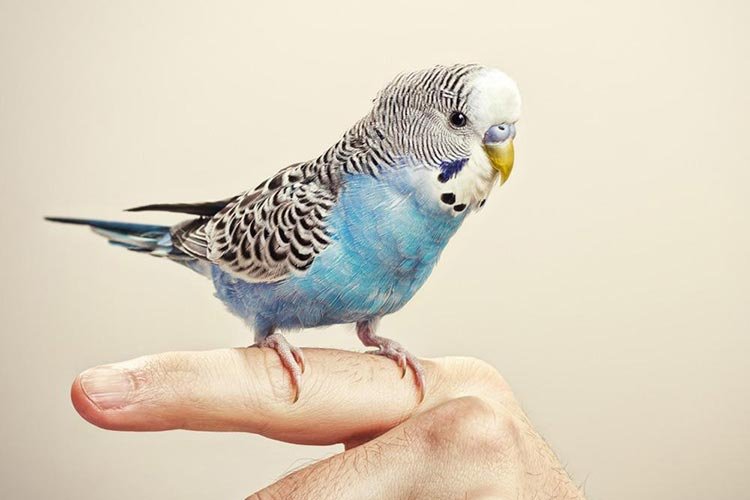
It’s normal for them to be afraid and to think that we’re going to hurt them, so first of all we must place the cage in a place where there are usually people so that the budgies get used to them. At first, you should also get close to the cage only to put some food and water, speaking to them in a soft tone of voice.
Once it’s used to the atmosphere of the house and your voice, it’s time to take a new step forward to gain its confidence. Don’t put your hand in the cage because it will scare the budgerigar. First of all, you have to get it on your finger.
To achieve this, you can put on your finger something to eat that it likes and offer it, such as lettuce or carrot. Day after day it will become more confident, until it finally gets on your finger. Once it’s done, you’ll have to caress her belly with your fingers. It requires a lot of patience, and under no circumstances should the parakeet be forced to climb on the finger.
Little by little you have to take the parakeet out of the cage to get on your finger, but it will not come out at first or it will fly away. It could be a big problem, since many parakeets will not want to return to their captivity when they know about freedom.
What you need to know before buying a parakeet
People commonly buy a parakeet in a pet shop, but unfortunately it’s not always the best idea. The reason is that pet shops sometimes don’t worry about the health of the budgies. They used to ne stressed animals because of living with many other ones.
But if you opt for this acquisition, the ones to avoid are:
- Those with smooth and unclear plumage, with tail feathers without forming the kind of silhouette of young birds.
- Budgies with many feathers at the bottom of the cage. It’s a sign that they have been easily removed and the parakeet may be sick.
- If feathers are sticky or dirty around budgerigar’s anus, and parakeet’s feet and claws are dirty, the bird’s not healthy.
- The beak is cracked and cere is dirty. They may make harsh noises and gasp for breath.
- The skin is usually pink, but if they have yellow skin, they may suffer of adipose degeneration.
How to clean a parakeet
Parakeets are very clean animals, but it is not enough for them to groom their beaks to keep them clean. In the summer, a water container is a good way to cool off while washing, but in the winter it’s also good for them to have a place to do so.
Don’t worry about how long its nails are, because with the bars of the cage, the bars of the swings and the poles of the hangers they will be of a reasonable size. If you decide to cut them, leave it to a professional. But if you do it once, you should always do it, because its nails will grow curved after the first cut.
It’s important to clean the cage a twice a week. Putting newsprint on the base of the cage makes it a little easier to clean. If the parakeet is trained, you can get it out of the cage during the cleaning task, so that it can spread its wings. The feeder should be cleaned once a day to remove the shells of the canaryseed, and the water should be cleaned three times a week to remove any microbes and bacteria.



